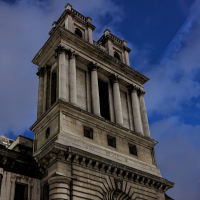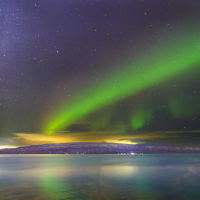Seemingly trivial things that intrigue you
Comments
-
Insofar as they died well before being able to get any serious illnesses, this was correct.webboo said:Bill Bryson book “At Home” gives a good history of how chimneys came in to being and the break through that made upper floors affordable in poorer homes.
When chimneys started to put on ordinary houses rather than just castles, people complained that they were colder and less healthy. They believed that being well kippered from the smoke stopped them getting ill.0 -
As clearly they were not dying of old age. What were they dying of.First.Aspect said:
Insofar as they died well before being able to get any serious illnesses, this was correct.webboo said:Bill Bryson book “At Home” gives a good history of how chimneys came in to being and the break through that made upper floors affordable in poorer homes.
When chimneys started to put on ordinary houses rather than just castles, people complained that they were colder and less healthy. They believed that being well kippered from the smoke stopped them getting ill.
0 -
Rickets.webboo said:
As clearly they were not dying of old age. What were they dying of.First.Aspect said:
Insofar as they died well before being able to get any serious illnesses, this was correct.webboo said:Bill Bryson book “At Home” gives a good history of how chimneys came in to being and the break through that made upper floors affordable in poorer homes.
When chimneys started to put on ordinary houses rather than just castles, people complained that they were colder and less healthy. They believed that being well kippered from the smoke stopped them getting ill.0 -
rjsterry said:
This is the bit that doesn't make sense. If the thatch is waterproof, how on earth do people think smoke is making it's way through? Or put the other way, if smoke could escape, rain would come straight through it.pblakeney said:Saw these while touring the Outer Hebrides.
Black house (Probably named for good reasons 😉)
The buildings were generally built with double wall dry-stone walls packed with earth, and were roofed with wooden rafters covered with a thatch of turf with cereal straw or reed. The floor was generally flagstones or packed earth and there was a central hearth for the fire. There was no chimney for the smoke to escape through. Instead the smoke made its way through the roof. This led to the soot blackening of the interior which may also have contributed to the adoption of name blackhouse.
The blackhouse was used to accommodate livestock as well as people. People lived at one end and the animals lived at the other with a partition between them.
I spoke to the roofers this afternoon - they confirmed that there was definitely no smoke hole, but that what's been preserved has been done so because the conservation officer assessed that the smoke-blackened thatch and timbers were historically significant. They're hoping to do the new thatch on the new timbers in January.0 -
Apparently only 2 to 8% of people died of Rickets in the 17 century, mainly wealthy children. So they be the ones with chimneys, so clearly smoke inhalation is a cure for Rickets.🔥🗣0
-
Quite by coincidence I was watching a documentary today in which it was explained that smoke from juniper branches has antiseptic qualities.webboo said:Apparently only 2 to 8% of people died of Rickets in the 17 century, mainly wealthy children. So they be the ones with chimneys, so clearly smoke inhalation is a cure for Rickets.🔥🗣
The above may be fact, or fiction, I may be serious, I may be jesting.
I am not sure. You have no chance.Veronese68 wrote:PB is the most sensible person on here.0 -
There are lots of things that kill organisms that also aren't good for us.pblakeney said:
Quite by coincidence I was watching a documentary today in which it was explained that smoke from juniper branches has antiseptic qualities.webboo said:Apparently only 2 to 8% of people died of Rickets in the 17 century, mainly wealthy children. So they be the ones with chimneys, so clearly smoke inhalation is a cure for Rickets.🔥🗣
Bleach, for example, is effective against COVID but shouldn't necessarily be used intravenously.0 -
I've asked my clever friend if he knows more about ancient thatch without smoke holes... will report back if he gets round to replying.
I've found a couple of examples of his work on a specific building in Exeter, with cutaway illustrations of what the house might have looked like in 1500 and then in 1650. I just love these. I so wish he'd do a limited edition book on lovely paper.

1 -
Quite, but in this specific example that is precisely what it was being used for.First.Aspect said:
There are lots of things that kill organisms that also aren't good for us.pblakeney said:
Quite by coincidence I was watching a documentary today in which it was explained that smoke from juniper branches has antiseptic qualities.webboo said:Apparently only 2 to 8% of people died of Rickets in the 17 century, mainly wealthy children. So they be the ones with chimneys, so clearly smoke inhalation is a cure for Rickets.🔥🗣
...The above may be fact, or fiction, I may be serious, I may be jesting.
I am not sure. You have no chance.Veronese68 wrote:PB is the most sensible person on here.0 -
Smoke probably did have a net positive health benefit as it would keep all sorts of pests at bay. There's a reason why smoking things preserves them.pblakeney said:
Quite by coincidence I was watching a documentary today in which it was explained that smoke from juniper branches has antiseptic qualities.webboo said:Apparently only 2 to 8% of people died of Rickets in the 17 century, mainly wealthy children. So they be the ones with chimneys, so clearly smoke inhalation is a cure for Rickets.🔥🗣
1985 Mercian King of Mercia - work in progress (Hah! Who am I kidding?)
Pinnacle Monzonite
Part of the anti-growth coalition0 -
If you had a small hole in either gable just below the ridge, this would work as a rudimentary chimney.briantrumpet said:rjsterry said:
This is the bit that doesn't make sense. If the thatch is waterproof, how on earth do people think smoke is making it's way through? Or put the other way, if smoke could escape, rain would come straight through it.pblakeney said:Saw these while touring the Outer Hebrides.
Black house (Probably named for good reasons 😉)
The buildings were generally built with double wall dry-stone walls packed with earth, and were roofed with wooden rafters covered with a thatch of turf with cereal straw or reed. The floor was generally flagstones or packed earth and there was a central hearth for the fire. There was no chimney for the smoke to escape through. Instead the smoke made its way through the roof. This led to the soot blackening of the interior which may also have contributed to the adoption of name blackhouse.
The blackhouse was used to accommodate livestock as well as people. People lived at one end and the animals lived at the other with a partition between them.
I spoke to the roofers this afternoon - they confirmed that there was definitely no smoke hole, but that what's been preserved has been done so because the conservation officer assessed that the smoke-blackened thatch and timbers were historically significant. They're hoping to do the new thatch on the new timbers in January.1985 Mercian King of Mercia - work in progress (Hah! Who am I kidding?)
Pinnacle Monzonite
Part of the anti-growth coalition1 -
rjsterry said:
If you had a small hole in either gable just below the ridge, this would work as a rudimentary chimney.briantrumpet said:rjsterry said:
This is the bit that doesn't make sense. If the thatch is waterproof, how on earth do people think smoke is making it's way through? Or put the other way, if smoke could escape, rain would come straight through it.pblakeney said:Saw these while touring the Outer Hebrides.
Black house (Probably named for good reasons 😉)
The buildings were generally built with double wall dry-stone walls packed with earth, and were roofed with wooden rafters covered with a thatch of turf with cereal straw or reed. The floor was generally flagstones or packed earth and there was a central hearth for the fire. There was no chimney for the smoke to escape through. Instead the smoke made its way through the roof. This led to the soot blackening of the interior which may also have contributed to the adoption of name blackhouse.
The blackhouse was used to accommodate livestock as well as people. People lived at one end and the animals lived at the other with a partition between them.
I spoke to the roofers this afternoon - they confirmed that there was definitely no smoke hole, but that what's been preserved has been done so because the conservation officer assessed that the smoke-blackened thatch and timbers were historically significant. They're hoping to do the new thatch on the new timbers in January.
"It either seeped out through the thatch or escaped at little vents in the ridge or gables. Smoke louvres are quite hard to spot at the best of times- they rarely survive!"0 -
I'm struggling to see how the combustion products of this particular plant might avoid the problems of any other combustion products, regardless of what else is in them.pblakeney said:
Quite, but in this specific example that is precisely what it was being used for.First.Aspect said:
There are lots of things that kill organisms that also aren't good for us.pblakeney said:
Quite by coincidence I was watching a documentary today in which it was explained that smoke from juniper branches has antiseptic qualities.webboo said:Apparently only 2 to 8% of people died of Rickets in the 17 century, mainly wealthy children. So they be the ones with chimneys, so clearly smoke inhalation is a cure for Rickets.🔥🗣
...
0 -
that reminds me of the stat that only 6 people died in The Great Firewebboo said:Apparently only 2 to 8% of people died of Rickets in the 17 century, mainly wealthy children. So they be the ones with chimneys, so clearly smoke inhalation is a cure for Rickets.🔥🗣
0 -
That makes sense. I remember accidentally lighting my parents fire with the flue shut once and I find it hard to believe people lived with that as the norm!briantrumpet said:rjsterry said:
If you had a small hole in either gable just below the ridge, this would work as a rudimentary chimney.briantrumpet said:rjsterry said:
This is the bit that doesn't make sense. If the thatch is waterproof, how on earth do people think smoke is making it's way through? Or put the other way, if smoke could escape, rain would come straight through it.pblakeney said:Saw these while touring the Outer Hebrides.
Black house (Probably named for good reasons 😉)
The buildings were generally built with double wall dry-stone walls packed with earth, and were roofed with wooden rafters covered with a thatch of turf with cereal straw or reed. The floor was generally flagstones or packed earth and there was a central hearth for the fire. There was no chimney for the smoke to escape through. Instead the smoke made its way through the roof. This led to the soot blackening of the interior which may also have contributed to the adoption of name blackhouse.
The blackhouse was used to accommodate livestock as well as people. People lived at one end and the animals lived at the other with a partition between them.
I spoke to the roofers this afternoon - they confirmed that there was definitely no smoke hole, but that what's been preserved has been done so because the conservation officer assessed that the smoke-blackened thatch and timbers were historically significant. They're hoping to do the new thatch on the new timbers in January.
"It either seeped out through the thatch or escaped at little vents in the ridge or gables. Smoke louvres are quite hard to spot at the best of times- they rarely survive!"- Genesis Croix de Fer
- Dolan Tuono0 -
Exactly.pangolin said:
That makes sense. I remember accidentally lighting my parents fire with the flue shut once and I find it hard to believe people lived with that as the norm!briantrumpet said:rjsterry said:
If you had a small hole in either gable just below the ridge, this would work as a rudimentary chimney.briantrumpet said:rjsterry said:
This is the bit that doesn't make sense. If the thatch is waterproof, how on earth do people think smoke is making it's way through? Or put the other way, if smoke could escape, rain would come straight through it.pblakeney said:Saw these while touring the Outer Hebrides.
Black house (Probably named for good reasons 😉)
The buildings were generally built with double wall dry-stone walls packed with earth, and were roofed with wooden rafters covered with a thatch of turf with cereal straw or reed. The floor was generally flagstones or packed earth and there was a central hearth for the fire. There was no chimney for the smoke to escape through. Instead the smoke made its way through the roof. This led to the soot blackening of the interior which may also have contributed to the adoption of name blackhouse.
The blackhouse was used to accommodate livestock as well as people. People lived at one end and the animals lived at the other with a partition between them.
I spoke to the roofers this afternoon - they confirmed that there was definitely no smoke hole, but that what's been preserved has been done so because the conservation officer assessed that the smoke-blackened thatch and timbers were historically significant. They're hoping to do the new thatch on the new timbers in January.
"It either seeped out through the thatch or escaped at little vents in the ridge or gables. Smoke louvres are quite hard to spot at the best of times- they rarely survive!"1985 Mercian King of Mercia - work in progress (Hah! Who am I kidding?)
Pinnacle Monzonite
Part of the anti-growth coalition0 -
Apparently Yeovilton and Dunkeswell are now in Dorset, according to the Telegraph. Top-notch journalism, as we expect from that esteemed organ.

0 -
Where on earth has Madri beer come from?
Seems to have appeared from absolutely nowhere to filling 1/3rd of ever supermarket beer shelf.0 -
Madrí Excepcional is a unique collaboration between the brewers of La Sagra & Molson Coors, with all the taste characteristics of a modern European lager.rick_chasey said:Where on earth has Madri beer come from?
Seems to have appeared from absolutely nowhere to filling 1/3rd of ever supermarket beer shelf.- Genesis Croix de Fer
- Dolan Tuono0 -
Seems to be the case every few years that some new 'European' beer becomes fashionable over here. I was the same with the likes of Peroni and Moretti. Maybe it will eventually be the turn of some decent Belgian stuff.rick_chasey said:Where on earth has Madri beer come from?
Seems to have appeared from absolutely nowhere to filling 1/3rd of ever supermarket beer shelf.0 -
-
Burton on Trent.rick_chasey said:Where on earth has Madri beer come from?
Seems to have appeared from absolutely nowhere to filling 1/3rd of ever supermarket beer shelf.
I can only apologise.1 -
I went on a tour of the Fullers brewery, allegedly, the water they use goes through a process called 'Burtonisation' to optimise it for brewing.Jezyboy said:
Burton on Trent.rick_chasey said:Where on earth has Madri beer come from?
Seems to have appeared from absolutely nowhere to filling 1/3rd of ever supermarket beer shelf.
I can only apologise.
I might have to Google that because although I definitely heard it, before sampling the product, it sounds odd.
ETA: It is a thing, they add gypsum to the water to increase the sulphate content.
https://en.wikipedia.org/wiki/Brewing_methods
0 -
veronese68 said:
I went on a tour of the Fullers brewery, allegedly, the water they use goes through a process called 'Burtonisation' to optimise it for brewing.Jezyboy said:
Burton on Trent.rick_chasey said:Where on earth has Madri beer come from?
Seems to have appeared from absolutely nowhere to filling 1/3rd of ever supermarket beer shelf.
I can only apologise.
I might have to Google that because although I definitely heard it, before sampling the product, it sounds odd.
ETA: It is a thing, they add gypsum to the water to increase the sulphate content.
https://en.wikipedia.org/wiki/Brewing_methodsHowever, excessive dosage must be avoided to prevent undesirable consequences, which could include a laxative effect.[15]1 -
Fuller's - helps you clear out from both ends.0
-
There is a thing we know as Pride aris', result of too much Burtonising it seems.First.Aspect said:Fuller's - helps you clear out from both ends.
0 -
https://www.nu.nl/economie/6292591/steeds-meer-fulltimers-gaan-minder-werken-aantal-deeltijders-op-recordniveau.html
Netherlands is approaching the point where almost half of all workers are part-time workers.0 -
It is as broad a definition 9f part time as possible,.yo generate an eye catching headline. Up to 36 hours.rick_chasey said:https://www.nu.nl/economie/6292591/steeds-meer-fulltimers-gaan-minder-werken-aantal-deeltijders-op-recordniveau.html
Netherlands is approaching the point where almost half of all workers are part-time workers.0 -
First.Aspect said:
It is as broad a definition 9f part time as possible,.yo generate an eye catching headline. Up to 36 hours.rick_chasey said:https://www.nu.nl/economie/6292591/steeds-meer-fulltimers-gaan-minder-werken-aantal-deeltijders-op-recordniveau.html
Netherlands is approaching the point where almost half of all workers are part-time workers.
Especially if somewhere like France (IIRC) the working week is 35 hours...0 -
Why are posts on here showing to me as being made an hour into the future (e.g this will show as 9.08)? I assume something has happened with my location data. I’ve also noticed the thing is back where I have to decline cookies every few times I open the forum.0










